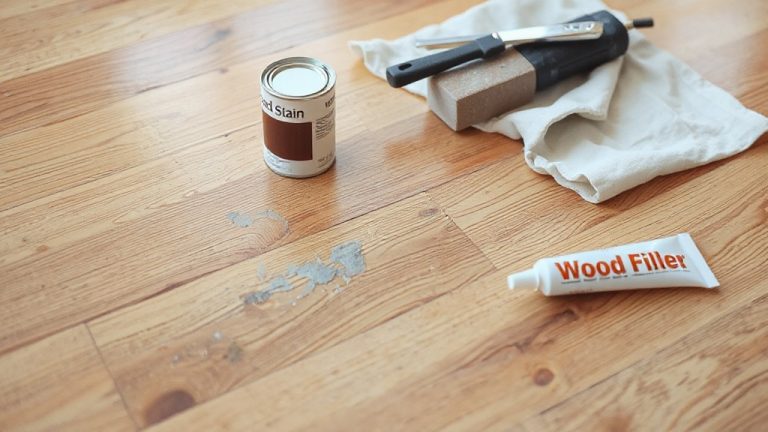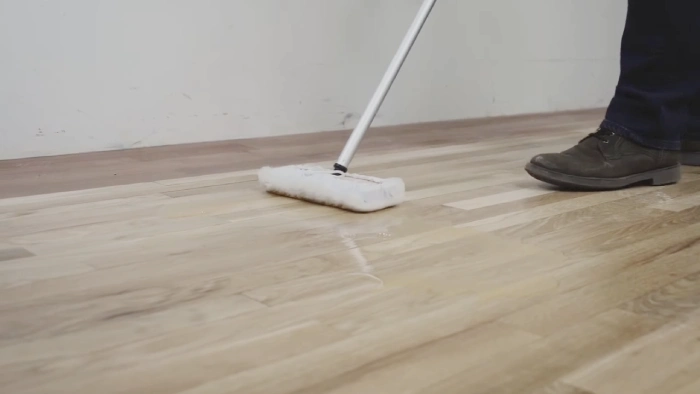Can You Use Engineered Hardwood in a Bathroom: 5 Facts to Know
Various types of flooring are available at home, and engineered hardwood is one popular option. Engineered hardwood is a type of flooring that combines the beauty of real wood with enhanced durability and moisture resistance. But can you really use engineered hardwood in a bathroom?
You can use engineered hardwood in a bathroom. It is a suitable option for bathrooms due to its ability to withstand moisture and humidity better than solid hardwood.
While wood and water don’t typically mix well, engineered wood features a plywood base that protects against moisture.
We’ll explain what you need to know before you install engineered hardwood so that you can maintain it.
What Should You Consider Before Installing Engineered Hardwood in a Bathroom?
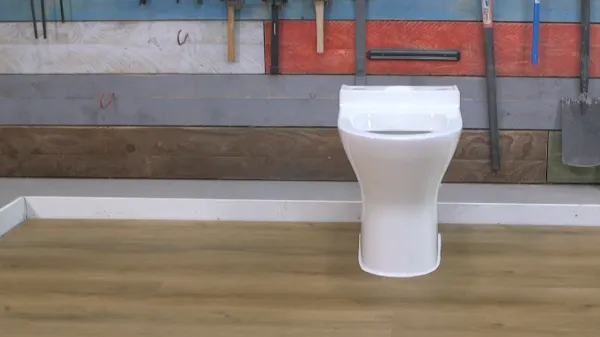
Before installing engineered hardwood in your bathroom, several factors must be considered. The factors are as follows:
1. Bathroom Size and Layout
2. Humidity and Moisture Levels
3. Household Traffic
4. Potential Water Exposure
5. Plumbing and Potential Leaks
Let’s take a look at the factors.
1. Bathroom Size and Layout
When planning your bathroom renovation, it’s crucial to consider the size and layout to determine if engineered hardwood is a suitable flooring option for you.
Spacious bathrooms with good air circulation and ventilation tend to be more suitable for engineered hardwood. This is because adequate airflow can help reduce humidity levels and minimize the potential for moisture-related issues.
On the other hand, if your bathroom is small and needs proper ventilation, there may be better choices to install engineered hardwood. The moisture from the shower, sink, and toilet can quickly cause damage to your flooring, leading to warping, cupping, or buckling.
Thus, weighing the pros and cons and consulting with a professional before making any final decisions is essential.
2. Humidity and Moisture Levels
To ensure a successful bathroom renovation, it’s crucial to evaluate the humidity and moisture levels in this naturally humid environment.
Bathrooms are often exposed to high humidity levels due to the regular use of showers, baths, and sinks. This humidity can negatively affect the performance of wood flooring, even if it’s engineered.
Therefore, it’s important to ensure that your bathroom has proper ventilation, such as an exhaust fan or window, to control humidity levels.
If humidity levels are not properly controlled, moisture can build up in your bathroom and cause a range of problems. This can include mold growth, which can be harmful to your health and difficult to remove.
Additionally, high humidity can lead to warping, swelling, and buckling in wood flooring. To prevent these issues, monitoring the humidity levels in your bathroom and taking appropriate steps to control moisture is important.
This can include using a dehumidifier, opening windows, or installing an exhaust fan to improve air circulation.
3. Household Traffic
Managing a family home’s daily hustle and bustle can take a toll on your bathroom flooring, even if it’s made to withstand wear and tear.
While engineered hardwood is generally more resistant to damage compared to solid hardwood, it’s still important to consider the level of household traffic your bathroom receives.
With kids running in and out of the bathroom, the constant foot traffic can impact the durability of your flooring over time. Use rugs or mats in high-traffic areas to prevent excessive wear and tear.
An important factor to consider regarding household traffic is the weight and frequency of usage.
If multiple family members frequently use your bathroom, the constant weight on the flooring can lead to scratches or dents. Additionally, if individuals wear shoes in the bathroom, it can cause damage to the surface.
Educating household members on proper bathroom etiquette is important and encouraging them to remove their shoes before entering is important.
4. Potential Water Exposure
Don’t let water damage ruin your beautiful bathroom flooring – be aware of the potential risks and take action to protect it.
While engineered hardwood is more moisture-resistant than solid hardwood, it is still susceptible to water damage if exposed to standing water or frequent spills.
Here are some things you can do to minimize the risk of water exposure in your bathroom:
- Place a rug or mat near the shower, sink, and toilet to catch any water spills and prevent them from seeping into the flooring.
- Wipe up any water spills immediately with a dry towel or mop to prevent them from penetrating the surface of the engineered hardwood.
- Use a bathroom fan or open a window to help reduce the humidity levels in the bathroom, as high humidity can damage the flooring over time.
- Consider using a waterproofing sealer on the engineered hardwood to provide an extra layer of protection against water damage.
5. Plumbing and Potential Leaks
If you neglect to inspect your plumbing regularly, leaks can cause significant damage to your flooring and home. Did you know that water damage is one of the most common and costly types of homeowners insurance claims, according to the Insurance Information Institute?
Plumbing issues can arise anytime, and it’s essential to be proactive to minimize the risk of water damage in your bathroom. Regularly inspect your plumbing for any visible leaks, such as dripping faucets or moisture around the pipes.
Additionally, ensure all bathroom fixtures, such as the toilet, shower, and sink, are properly sealed to prevent water from seeping into the flooring.
How Should You Maintain Engineered Hardwood in a Bathroom?
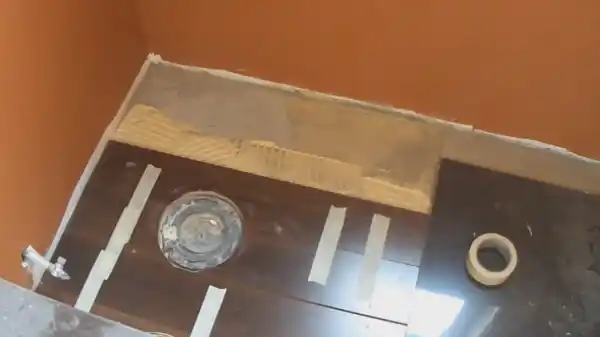
To maintain your engineered hardwood flooring in a bathroom, regular cleaning is crucial. Here’s what you have to do:
1. Regular Cleaning
Keep your engineered hardwood flooring in the bathroom clean by using a soft-bristle broom, microfiber mop, or vacuum cleaner with a soft brush attachment to avoid any damage to the surface. Regular cleaning is necessary to remove dirt, dust, and other debris that can accumulate on the floor.
Here are some tips to help you properly clean your engineered hardwood flooring:
- Use a soft-bristle broom to sweep the floor daily to remove loose dirt and dust.
- If you prefer to mop the floor, use a microfiber mop or a damp mop with a small amount of cleaning solution. Avoid using excessive water as the moisture can seep into the seams and cause damage to the flooring.
- When vacuuming, use a soft brush attachment to avoid scratching the surface.
2. Promptly Clean Spills
When spills happen, don’t let them sit for too long or they’ll seep into the floor like a thirsty sponge. Engineered hardwood flooring can withstand some water, but it’s not indestructible. If you’re not careful, moisture can penetrate the surface and cause damage to your flooring.
That’s why cleaning up any spills in your bathroom promptly is important. To clean up spills, use a soft, absorbent cloth or paper towel to blot the area dry. Don’t let water or other liquids sit on the floor for an extended period.
If you let the spill sit for too long, it can seep into the seams between the planks and cause warping or cupping.
So, make sure to dry the area thoroughly and avoid using harsh chemicals or cleaners that can damage the finish of your flooring.
3. Avoid Harsh Chemical Cleaners
Now that you know the importance of cleaning up spills promptly, let’s talk about how to clean your engineered hardwood flooring in the bathroom without causing damage.
It’s important to avoid using harsh chemical cleaners or abrasive cleaning agents, as these can compromise the water resistance of the flooring and damage the finish. Instead, opt for a manufacturer-recommended hardwood floor cleaner or a mild soap solution mixed with water for occasional deep cleaning.
When cleaning your engineered hardwood flooring in the bathroom, it’s important to take a gentle approach. Here are some tips to keep in mind:
- Use a hardwood floor cleaner recommended by the manufacturer or a mild soap solution mixed with water for deep cleaning on occasion.
- Don’t use harsh chemicals or abrasives, which can damage the finish and potentially compromise the water resistance of the flooring.
- Clean up spills promptly to prevent damage to the flooring and ensure it looks great for years to come.
4. Protect High-Risk Areas
To safeguard areas prone to moisture buildup, place absorbent mats near the shower, sink, and toilet to prevent damage to your bathroom flooring.
These high-risk areas are places where water or moisture is more likely to accumulate, such as in front of the shower or bath, near the sink, or by the toilet.
By placing absorbent rugs or mats in these areas, you can help reduce the risk of water damage to your flooring.
In addition to providing an extra layer of protection for your floor, absorbent mats can also help absorb moisture and prevent slips and falls.
They’re available in a variety of sizes, colors, and materials, so you can choose the best option for your bathroom decor.
5. Control Humidity Levels
Proper ventilation is crucial in keeping your bathroom dry and comfortable, allowing your engineered hardwood to thrive and avoid becoming a soggy swamp.
You can achieve this by installing an exhaust fan or a window that can be opened to allow fresh air to circulate and reduce excess moisture. This will help prevent excessive humidity levels that may affect the performance of the engineered hardwood.
Humidity is a major enemy of engineered hardwood, and it can cause your flooring to warp, buckle, or even cup over time.
To keep your bathroom humidity levels in check, make sure to use a dehumidifier if necessary. Additionally, avoid leaving wet towels or clothes on the bathroom floor, as this can add to the moisture levels in the air.
6. Address Plumbing Issues Promptly
Refrain from letting plumbing issues go unchecked, or you could be facing costly water damage to your beautiful engineered hardwood flooring in the bathroom. It’s important to address plumbing problems promptly to keep your floors dry.
Here are three steps you can take to address plumbing issues in your bathroom:
- Regularly inspect your plumbing fixtures – Check all the fixtures in your bathroom, including sinks, toilets, and showers, for any leaks or drips. Keep an eye out for any signs of water damage, such as discolored or warped flooring. If you notice any issues, fix them immediately to prevent further damage.
- Hire a professional plumber – If you need more time fixing plumbing issues yourself, hire a licensed plumber to inspect and repair any problems. A professional plumber can identify any hidden leaks and make sure your plumbing system is functioning properly.
- Install water alarms – Consider installing water alarms in your bathroom to detect any leaks or water damage. These alarms can alert you to potential problems before they become major issues, giving you time to address the problem before it causes significant damage to your flooring.
How do you clean bathroom-engineered hardwood floors?

Cleaning your bathroom’s engineered hardwood floors is easy with a gentle cleaning mixture of warm water and dish soap.
Start by dusting or sweeping the floors well. Then, mix 4 cups of warm water with a few drops of dish soap to create a cleaning solution.
Gently mix the solution and apply it to small sections of your bathroom’s floors, either by mopping or scrubbing. Remember to dry each section as you go with a clean cloth or dry mop.
To ensure that your engineered hardwood floors stay in top shape, it’s important to use the right cleaning tools.
Avoid using harsh chemicals or abrasive cleaning pads, as they can damage the protective coating on your floors. Instead, gently clean the floors with a soft-bristled brush or microfiber mop.
How long does engineered hardwood flooring typically last in a bathroom setting?
If you want your bathroom flooring to last for many years, it’s important to consider factors such as quality, maintenance, and conditions.
Generally, well-maintained engineered hardwood flooring can last for 20 to 30 years or even longer in a bathroom. However, neglecting maintenance, inadequate ventilation, and excessive exposure to moisture can shorten the lifespan of the flooring.
Can you waterproof an engineered hardwood floor in the bathroom?
To ensure your bathroom floor stays dry as a bone, slather on a waterproof seal or finishing agent, like a polyurethane-based sealer, and apply multiple coats for extra protection against moisture.
This will create a strong and durable barrier between the wood and water, helping to prevent moisture from penetrating the flooring and minimizing the risk of water damage.
It’s important to follow the manufacturer’s instructions when applying the sealer, and to consider applying multiple coats for extra protection.
To further protect your engineered hardwood floor in the bathroom, it’s recommended to perform regular maintenance and prompt cleanups of spills.
Even with waterproofing, moisture can still seep in if spills are left unattended or if the floor needs to be cleaned regularly.
Maximize the Durability of Engineered Hardwood Flooring in Your Bathroom
You’re now well-informed about using engineered hardwood flooring in bathrooms. Before installing this type of flooring, it’s important to consider the potential risks and benefits.
Although engineered hardwood is popular for its durability, there may be better options for high-moisture environments like bathrooms.
Many homeowners who installed engineered hardwood in their bathrooms regretted it due to swelling, warping, and water damage. To prevent these issues, proper precautions and maintenance measures are essential.Despite the risks, engineered hardwood flooring can last for many years in a bathroom with regular maintenance and necessary steps to protect it from water damage.

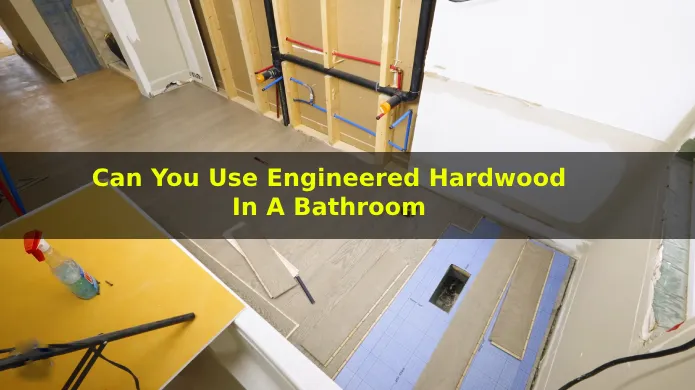

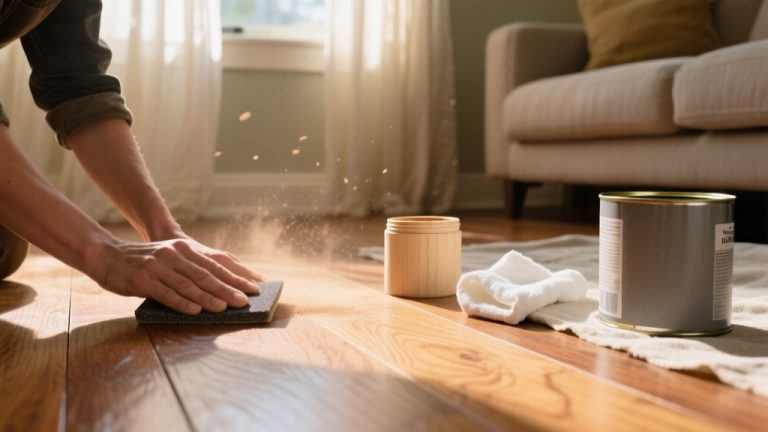
![How to Clean Syrup off Hardwood Floors: 6 Steps [DIY]](https://anyshelter.com/wp-content/uploads/2023/06/How-to-Clean-Syrup-off-Hardwood-Floors.webp)
